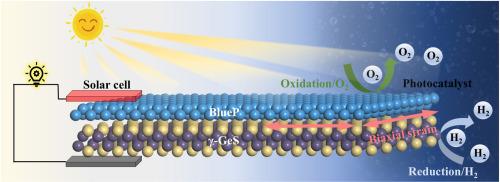应变工程Z-scheme γ-GeS/BlueP异质结构用于高效光电辅助制氢
IF 8.3
2区 工程技术
Q1 CHEMISTRY, PHYSICAL
引用次数: 0
摘要
具有高太阳能转换效率的垂直堆叠范德华异质结构的设计为实现碳中和提供了一条有希望的途径。我们的第一性原理计算表明,γ-GeS/BlueP异质结是一种窄带隙半导体,具有高载流子迁移率和强可见光吸收。适度的平面内应变将异质结从i型转变为ii型带对准,并通过z型光催化机制实现整体水分裂。在- 3%的双轴应变下,预测的太阳能制氢效率(ηSTH)达到12.21%,功率转换效率(PCE)达到15.08%。当压缩应变增加到- 4%时,ηSTH提高到18.06%,ηSTH/PCE比明显大于- 3%时。此外,析氢反应(HER)的氢吸附自由能(ΔGH∗)从−3%时的1.14 eV急剧下降到−4%时的0.46 eV,表明HER活性明显增强。压缩应变还增加了空穴迁移率,增强了面内各向异性,有利于光激发电子-空穴对的有效分离和输运。这些应变可调的特性突出了γ-GeS/BlueP作为太阳能转换的潜在双功能平台,特别是在光伏辅助制氢方面。本文章由计算机程序翻译,如有差异,请以英文原文为准。

Strain-engineered Z-scheme γ-GeS/BlueP heterostructures for efficient photovoltaic-assisted hydrogen generation
The purposeful design of vertically stacked van der Waals heterostructures with high solar energy conversion efficiency offers a promising route toward carbon neutrality. Our first-principles calculations show that the γ-GeS/BlueP heterojunction is a narrow bandgap semiconductor with high carrier mobilities and strong absorption across the visible region. Modest in-plane strain transforms the heterojunction from type-I to type-II band alignment and enables overall water splitting through a Z-scheme photocatalytic mechanism. At −3 % biaxial strain, the predicted solar-to-hydrogen efficiency (ηSTH) reaches 12.21 % and the power conversion efficiency (PCE) reaches 15.08 %. Increasing the compression strain to −4 % raises ηSTH to 18.06 % and yields a substantially larger ηSTH/PCE ratio than at −3 %. Furthermore, the hydrogen adsorption free energy (ΔGH∗) for hydrogen evolution reaction (HER) decreases sharply from 1.14 eV at −3 % strain to 0.46 eV at −4 %, indicating markedly enhanced HER activity. Compressive strain also increases hole mobility and strengthens in-plane anisotropy, which facilitates efficient separation and transport of photoexcited electron-hole pairs. These strain-tunable properties highlight γ-GeS/BlueP as a potential bifunctional platform for solar energy conversion, particularly for photovoltaic-assisted hydrogen production.
求助全文
通过发布文献求助,成功后即可免费获取论文全文。
去求助
来源期刊

International Journal of Hydrogen Energy
工程技术-环境科学
CiteScore
13.50
自引率
25.00%
发文量
3502
审稿时长
60 days
期刊介绍:
The objective of the International Journal of Hydrogen Energy is to facilitate the exchange of new ideas, technological advancements, and research findings in the field of Hydrogen Energy among scientists and engineers worldwide. This journal showcases original research, both analytical and experimental, covering various aspects of Hydrogen Energy. These include production, storage, transmission, utilization, enabling technologies, environmental impact, economic considerations, and global perspectives on hydrogen and its carriers such as NH3, CH4, alcohols, etc.
The utilization aspect encompasses various methods such as thermochemical (combustion), photochemical, electrochemical (fuel cells), and nuclear conversion of hydrogen, hydrogen isotopes, and hydrogen carriers into thermal, mechanical, and electrical energies. The applications of these energies can be found in transportation (including aerospace), industrial, commercial, and residential sectors.
 求助内容:
求助内容: 应助结果提醒方式:
应助结果提醒方式:


